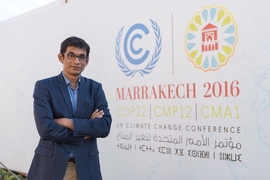As the world’s second fastest-growing major economy and third largest producer of greenhouse gas emissions, India is at a crossroads.
Intent on raising its standard of living and extending reliable access to electricity to the nearly 19 percent of its citizens who lack it, India is expected to more than double its energy consumption by 2040, according to the International Energy Agency. At the same time, the nation has pledged to make reductions in greenhouse gas emissions intensity (the ratio of carbon dioxide emissions produced to gross domesting product) as specified in the 2015 Paris Agreement on climate. Achieving these seemingly conflicting goals will require energy technologies and policies that are both economically viable and efficient at cutting emissions.
That's why Arun Singh, a master’s degree student in the Institute for Data, Systems and Society’s Technology and Policy Program (TPP), decided to help India's decision makers weigh their options. Singh, who is also a fellow of the Tata Center for Technology and Design and a research assistant in the MIT Joint Program on the Science and Policy of Global Change, has analyzed climate policy options for India by building and applying a model of the Indian economy with detailed representation of the electricity sector.
Developed with his advisors, MIT Sloan School of Management Assistant Professor Valerie Karplus and MIT Joint Program Principal Research Scientist Niven Winchester, the model enables researchers to gauge the cost-effectiveness and efficiency of different technology and policy choices designed to transition India to a low-carbon energy system. Singh used the model to assess the economic, energy, and emissions impacts of implementing India’s Nationally Determined Contribution (NDC) to the Paris Agreement — which aims to reduce carbon dioxide emissions intensity by 33 to 35 percent from 2005 levels and increase non-fossil based electric power to about 40 percent of installed capacity by 2030.
Singh determined that compared to a reference scenario of no policy constraints, an economy-wide emissions intensity reduction policy (simulated as a carbon price) would cost at least 43 times less per ton of carbon dioxide than a mandated expansion of non-fossil-based electric power capacity. He also found that an economy-wide emissions-intensity reduction policy would also reduce carbon dioxide emissions in all sectors of the economy, whereas a non-fossil mandate in the electric power sector would lead to increased emissions beyond that sector.
These findings appear in Singh’s master’s thesis, “Clean Development Pathways for India: Evaluating Feasibility and Modeling Impact of Policy Options,” which was awarded the honor of being the TPP's best master’s thesis for 2017.
“Arun’s thesis stands out because it goes beyond modeling policy options for meeting India’s climate goals to evaluating their feasibility in practice, based on an on-the-ground understanding of India’s institutions, stakeholders and technology,” Karplus says. “This combination has produced results that are likely to be both relevant and actionable for policymakers in India.”
Singh’s paper may also have broader application.
“The thesis extends a single-country modeling framework that can be used to analyze the impacts of policies consistent with the Paris Agreement in other countries,” Winchester says.
Singh’s model projects that achieving India’s NDC emissions intensity target with a so-called pure carbon pricing policy (in which no additional targets are set to expand non-fossil electric power capacity) would require a price of $17.40 per metric ton of carbon dioxide. Because this is a higher carbon price than what’s been implemented in most developed countries, Singh acknowledges the political intractability of such a policy. If a carbon pricing policy were combined with enforcement of non-fossil electric power capacity targets, the carbon price would go down to $2.06, but consumers would face higher commodity prices resulting from more expensive utilities. However, declining wind and solar costs in the future could lead to lower utility prices, making a hybrid carbon pricing/electric power capacity expansion policy a viable option to meet India’s electric power demand and climate goals.
Singh shared preliminary findings from his research on clean energy development pathways for India last November as a panelist for a side event of COP22, the 2016 United Nations Climate Change Conference in Marrakech, Morocco. He was the only graduate student among nine speakers on the panel, which explored strategies to implement the Paris Agreement.
“With this modeling endeavor, we aim to provide policymakers in India with a tool that they can use to assess the impacts of proposed climate policies,” says Singh, who will receive a master of science degree in technology and policy at Commencement this week.
Upon graduation, Singh plans to continue working with Karplus and Winchester on expanding the model’s capabilities and developing collaborations with policymaking bodies in India.







